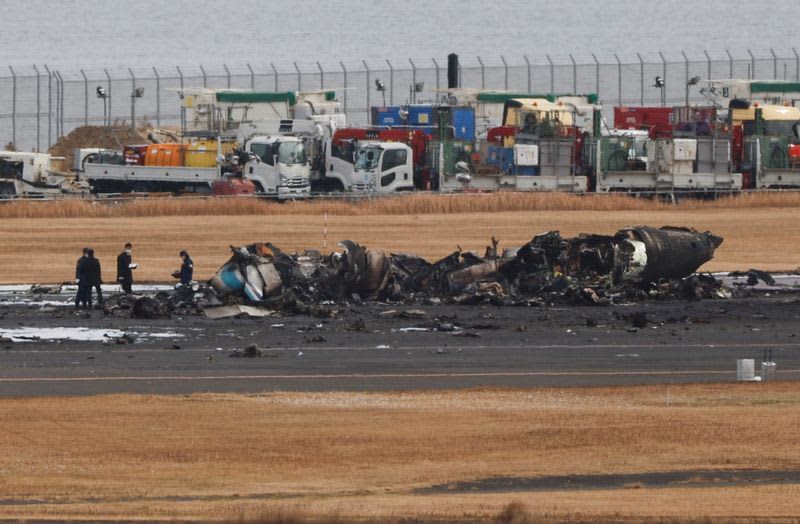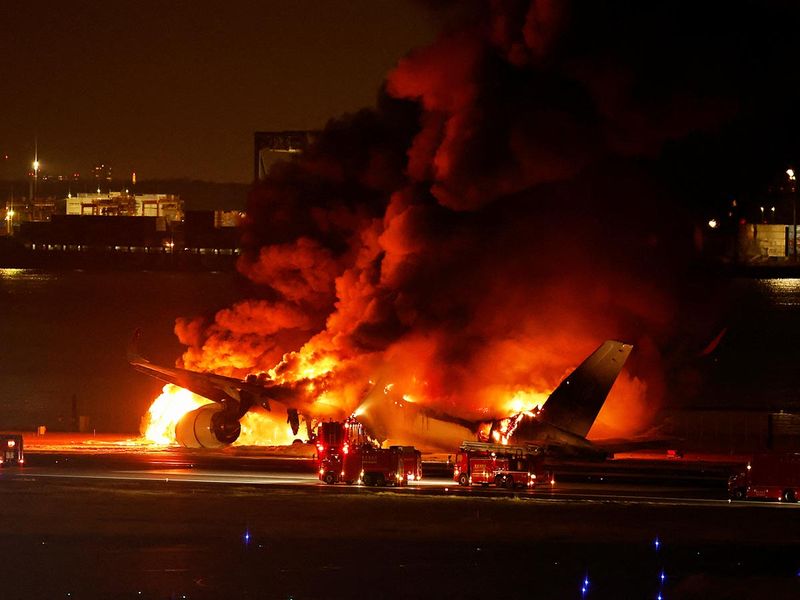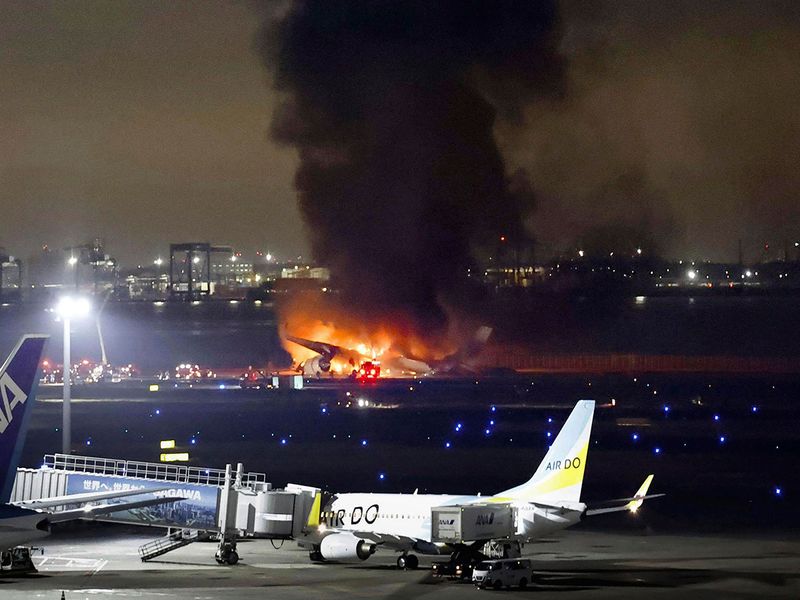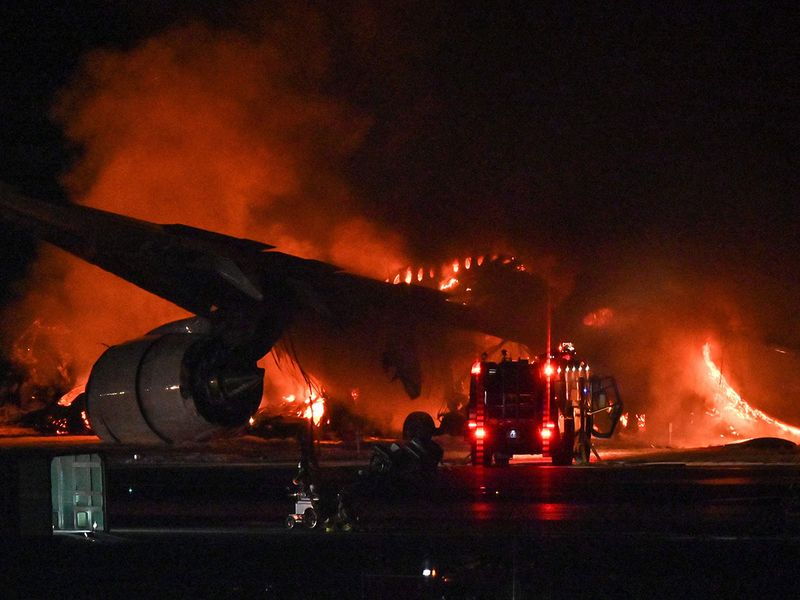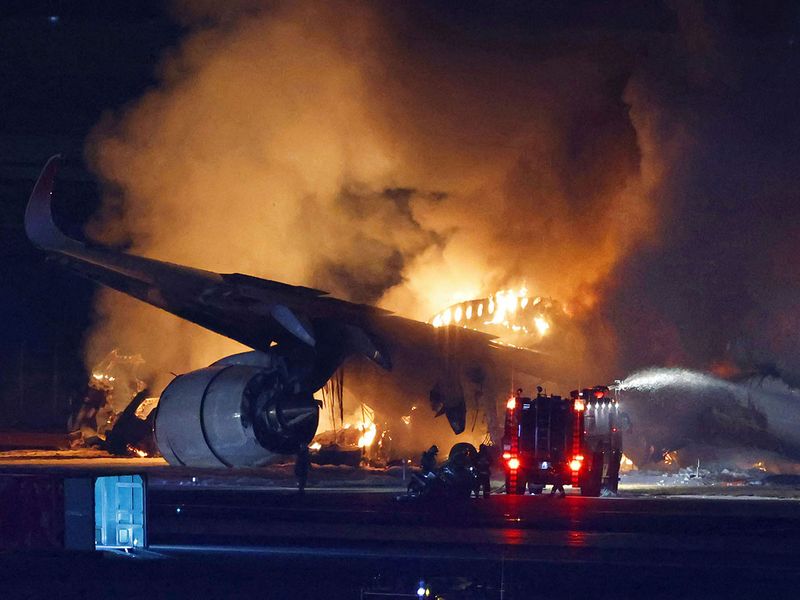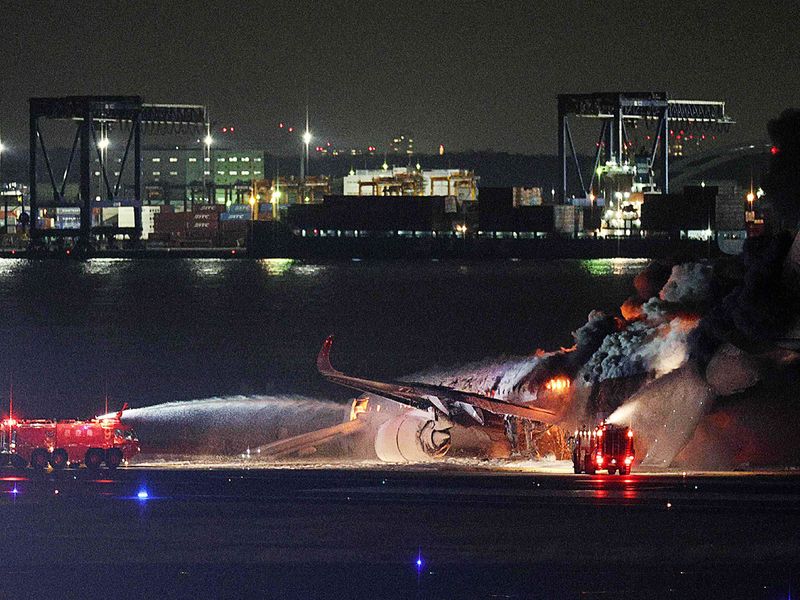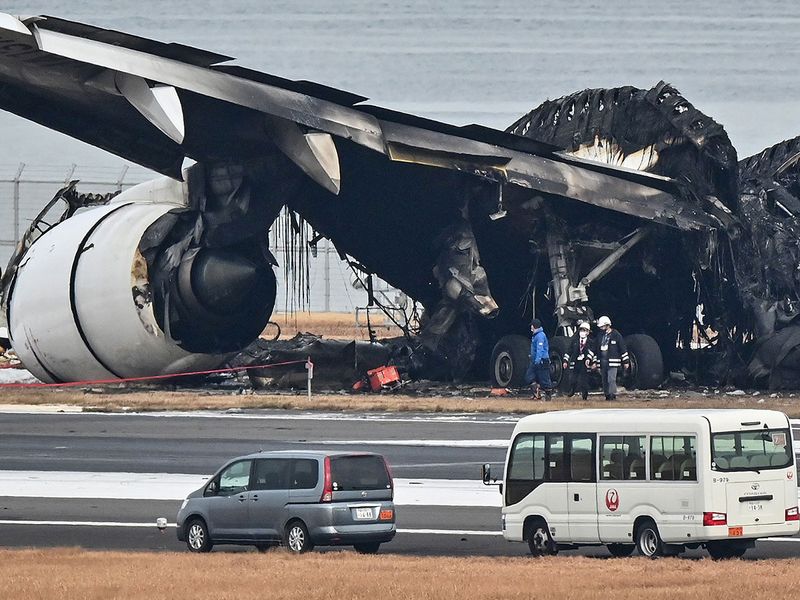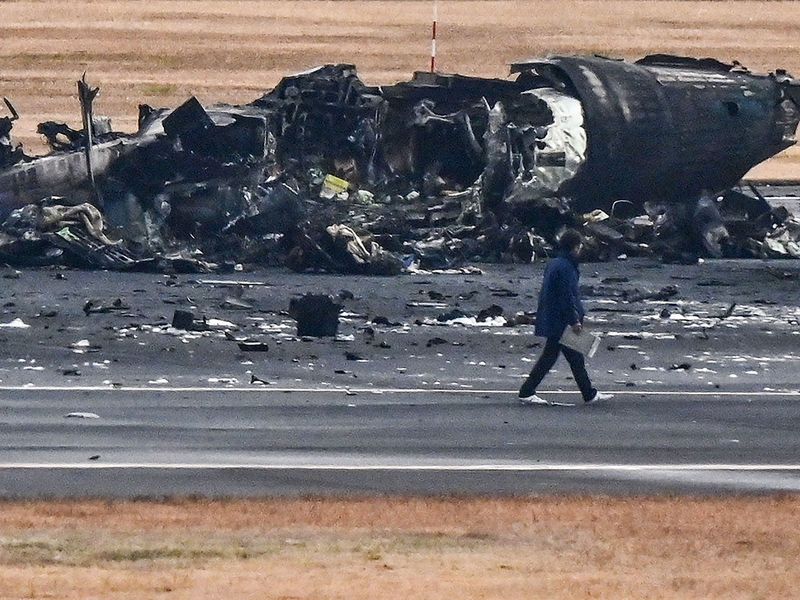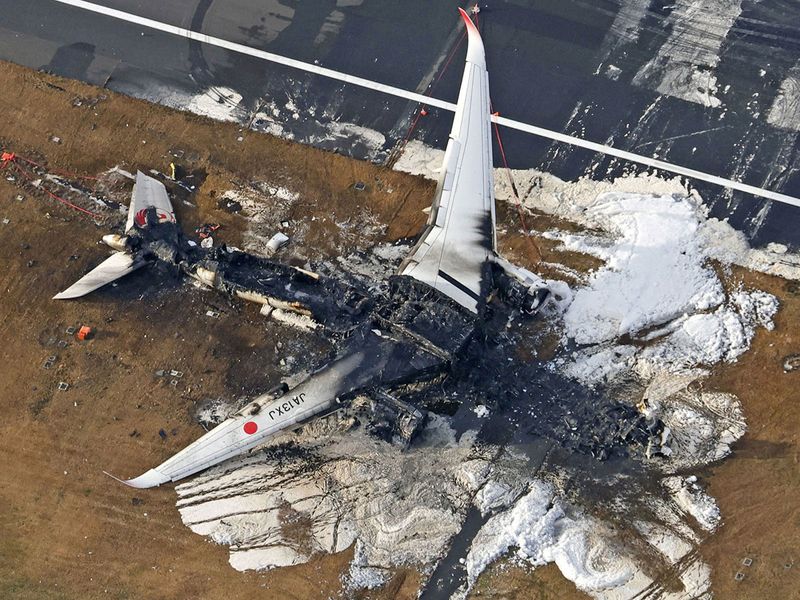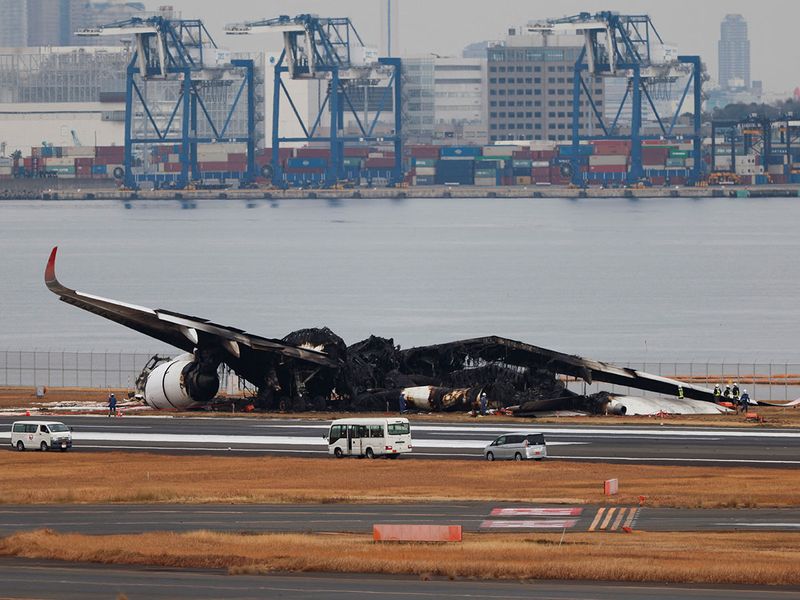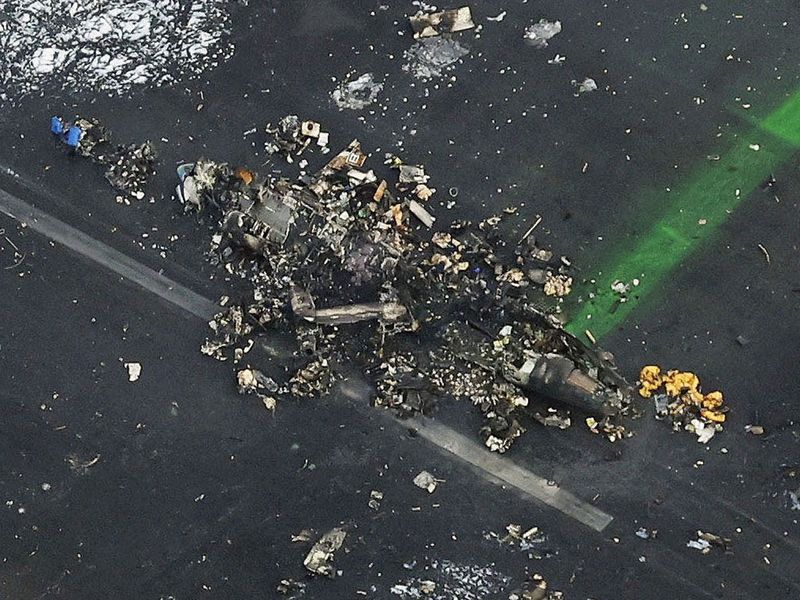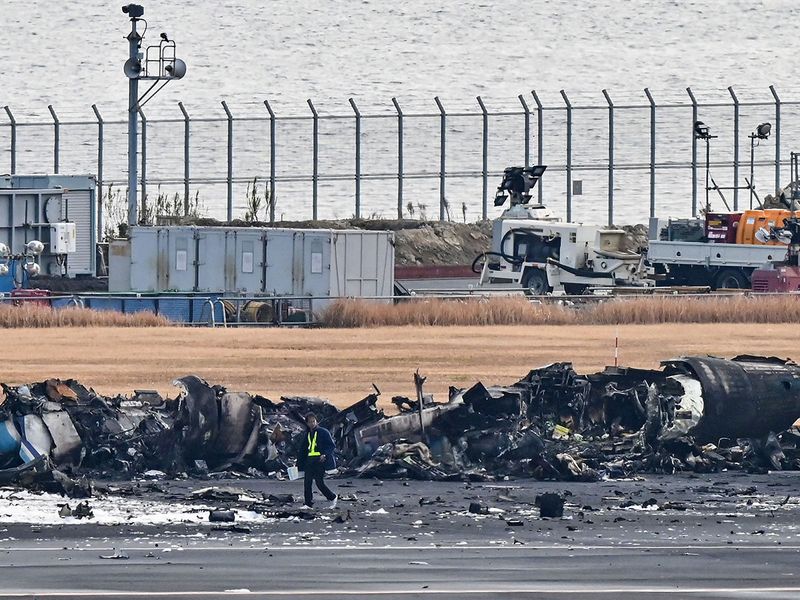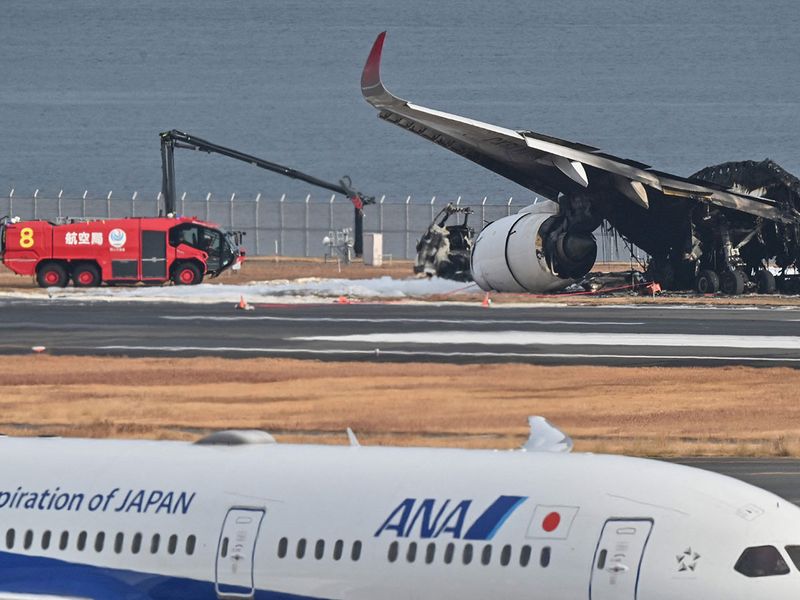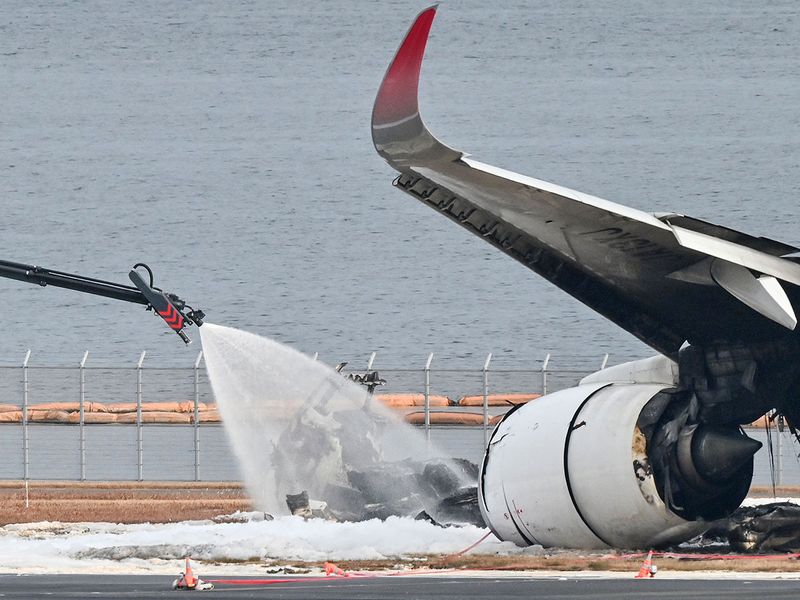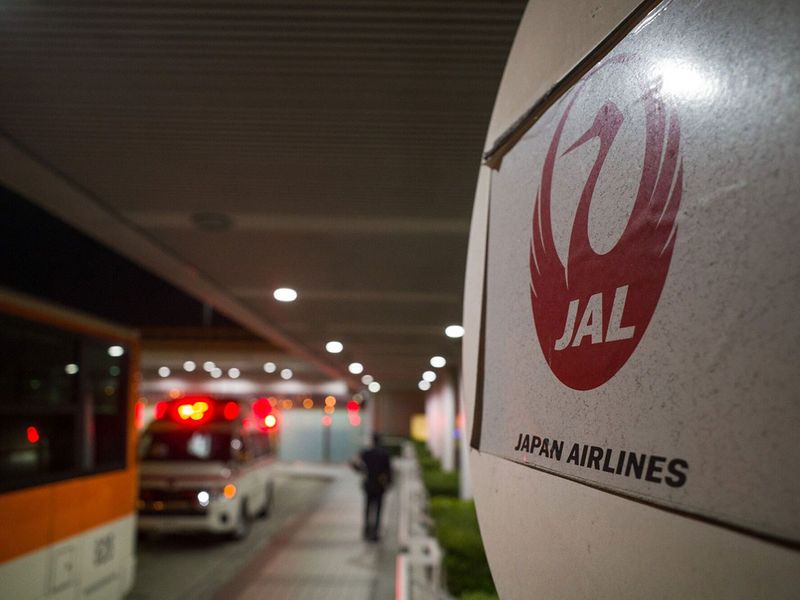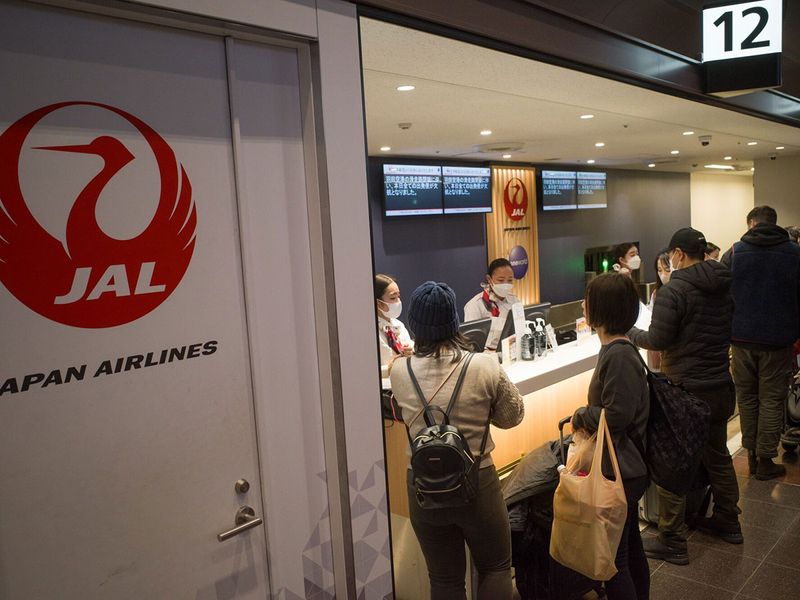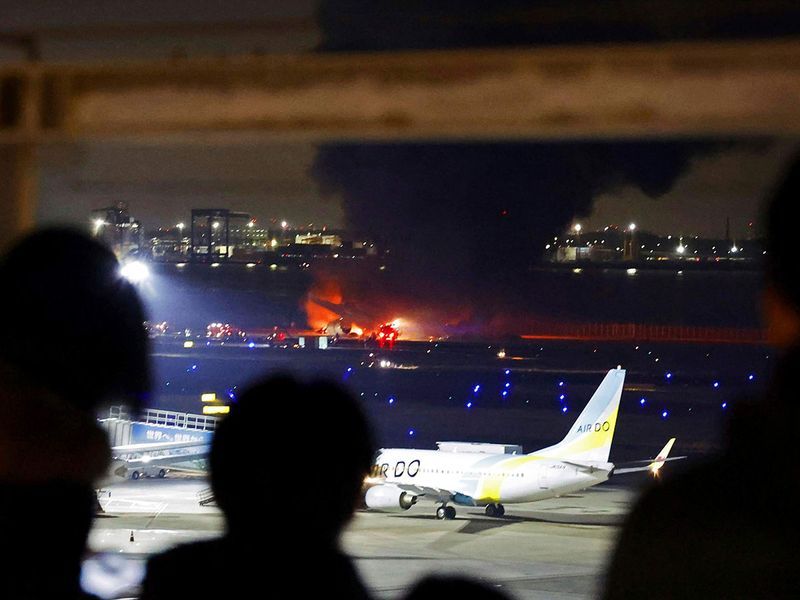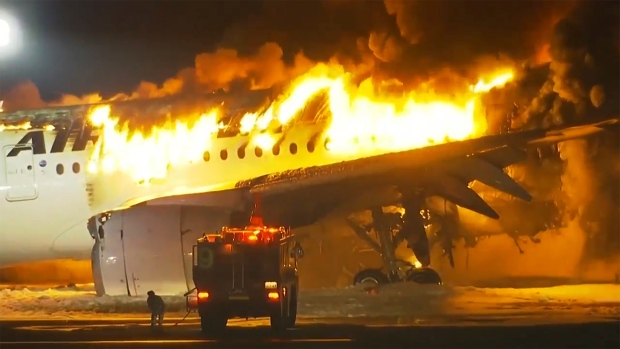As Japan Airlines Co. Flight 516 approached Tokyo’s Haneda Airport late on Tuesday afternoon, all signs pointed to an uneventful conclusion to the routine 1.5-hour journey from Sapporo in northern Japan.
At 5:43 p.m. local time, control-tower staff told pilots of the Airbus SE A350-900 jet to continue their approach into Haneda. A minute and a half later, the flight was given clearance to land, according to audio posted on LiveATC.net, which tracks airport communications.
Less than three minutes after that, the jetliner with 379 people aboard was in flames, having struck a much smaller De Havilland Canada Dash 8 operated by the Japanese coast guard just as it touched down.
“We have a fire on runway 34R,” an unidentified speaker said.
The collision on 34R, also known as Runway C, set off a fireball at the point of impact, with video of the incident showing the JAL widebody bursting into flames as it skidded down the runway to a stop. Quick rescue work allowed all 367 passengers and 12 crew members to escape, even as smoke filled the A350’s cabin. Five of the six crew on the coast guard plane that was preparing to depart for an earthquake relief mission have died, according to the government.
At a press conference Tuesday night, JAL officials said they believed Flight 516 had permission to land, though they weren’t yet drawing conclusions. It wasn’t clear whether the coast guard plane was also given clearance to be on the runway — instructions were garbled on the ATC recording.

Human error on the part of the airline, the coast guard or the controllers is possible, said Kotaro Toriumi, a Japanese travel and aviation analyst.
Japanese transport ministry and coast guard officials said Tuesday evening they were investigating the cause of the incident and how it could have been prevented. The ministry’s transport safety board will seek to determine whether any miscommunication occurred in the air traffic control operation.
Airbus said it will provide technical assistance to French and Japanese authorities investigating the crash, while Japanese Prime Minister Fumio Kishida, already contending with a major earthquake in the new year, ordered aid to the possible victims.
JL516 took off from New Chitose airport near Sapporo at 4:27 p.m. local time, according to FlightRadar24. The two-year-old A350 landed at 5:47 p.m. and was quickly thrown into an emergency.
Footage posted on social media by fleeing passengers showed emergency slides deployed at exits on both sides of the aircraft, which could be seen tilted forward with a collapsed front landing gear, flames licking its windows and smoke billowing over the fuselage as fire services battled the blaze.
Later footage showed the entire plane engulfed in a massive blaze, damaging the aircraft beyond repair. Broadcaster NHK said that at least 17 people on the JAL flight were injured.
Modern aircraft need to be able to completely evacuate in no more than 90 seconds, using only half the number of their available emergency slides. To gain certification, manufacturers conduct drills with fully loaded aircraft under simulated chaotic conditions. Even the giant Airbus A380 has managed to empty out in that time window, with a few seconds to spare.
Officials said the captain of the smaller plane was able to escape the crash and has regained consciousness.
The aircraft is the first A350 hull to be destroyed by an accident. Japan Airlines operates a fleet of 16 A350-900s, seating either 369 or 391 passengers in a so-called high density domestic configuration. The carrier has been flying the type since 2019.
On-ground impacts between aircraft are rare and damage is typically minor because collisions tend to happen during slower taxiing. The worst disaster in aviation history happened during a ground collision in 1977, when two Boeing 747 jumbo jets collided on the runway at Los Rodeos Airport on the Spanish island of Tenerife, killing 583 people.
Haneda Airport hasn’t suffered a fatal aircraft accident since February 1982, when a McDonnell Douglas operated by JAL crashed near the airfield into Tokyo Bay, resulting in the death of 24 of the 174 people on board, according to the Aviation Safety Network.
The hub was temporarily closed after Tuesday’s accident. JAL officials declined to provide details of Wednesday’s schedule.
“We aim to revive flight operations at Haneda as soon as possible” Tetsuo Saito, minister of land, infrastructure, transport and tourism, said Tuesday evening at a briefing.
With assistance from Anthony Palazzo, Go Onomitsu, Nicholas Takahashi, Jon Herskovitz, Dave Merrill, Shoko Oda and Masatsugu Horie.
Runway safety concerns in focus as Japan
probes Tokyo crash

Firefighters work on a burning Japan Airlines' A350 airplane at Haneda International Airport, in Tokyo, Japan, Jan 2, 2024.
PHOTO: Reuters
PUBLISHED ONJANUARY 02, 2024 6:30 PM
PARIS — Japanese investigators are preparing to probe the collision of two airplanes at Tokyo's Haneda airport, weeks after the global airline industry heard fresh warnings about runway safety.
All 379 people aboard a Japan Airlines Airbus A350 escaped after a collision with a De Havilland Dash-8 Coast Guard turboprop that killed five of six crew on the smaller aircraft.
People familiar with the investigation said the Japan Safety Transport Board (JTSB) would lead the probe with participation from agencies in France, where the airplane was built, and Britain where its two Rolls-Royce engines were manufactured.
Experts have cautioned it is too early to pinpoint a cause and stress most accidents are caused by a cocktail of factors.
But investigators are widely expected to explore what instructions were given by controllers to the two aircraft, alongside a detailed examination of plane and airport systems.
A ministry official told reporters in Japan on Tuesday (Jan 2) that the A350 was attempting to land normally when it collided with the Coast Guard plane, also known as a Bombardier Dash-8.

Japan Airlines' A350 airplane is on fire at Haneda international airport in Tokyo, Japan, Jan 2, 2024.
PHOTO: Reuters
One of the first tasks will be to recover black box recorders with flight data and cockpit voice recordings.
Experts said the location of the accident means physical evidence, radar data and witness accounts or camera footage are likely to be readily available, easing the huge forensic task.
"One obvious question is whether the coastguard plane was on the runway and if so why," said Paul Hayes, director of aviation safety at UK-based consultancy Ascend by Cirium.
The crash is the first significant accident involving the Airbus A350, Europe's premier twin-engined long-haul jet, in service since 2015.
And according to preliminary 2023 data, the collision of the Coast Guard plane with a two-year-old jetliner three times its length follows one of the safest years in aviation.
But it also comes after a US-based safety group warned last month about the risk of runway collisions or "incursions".
The Flight Safety Foundation called for global action to prevent a new uptick in runway incursions as skies become more congested.
"Despite efforts over the years to prevent incursions, they still happen," CEO Hassan Shahidi said in a statement.
"The risk of runway incursions is a global concern, and the potential consequences of an incursion are severe."
Although ground collisions involving injury or damage have become rare, their potential for loss of life is among the highest of any category and near-misses are more common.
A collision between two Boeing 747s in Tenerife in 1977, killing 583 people, remains aviation's most deadly accident.
'Technology gap'
The Washington-based foundation has found that breakdowns in communication and coordination can play a role in runway crashes or near misses.
But a shortage of electronics to avoid collisions on the ground, rather than in the air where software to trigger avoidance has been available since the 1980s, is also a concern.
"Many of the serious incidents could have been avoided through better situational awareness technologies that can help air traffic controllers and pilots detect potential runway conflicts," Shahidi said.
The Federal Aviation Administration says some three dozen US airports are fitted with a system called ASDE-X that uses radar, satellites and a navigation tool called multilateration to track ground movements.

5 on coast guard aircraft die after collision with Japan Airlines plane at Tokyo's Haneda airport
But National Transportation Safety Board chair Jennifer Homendy said in November the US aviation network — a bellwether for airports worldwide — lacks sufficient technology to prevent runway incursions.
In 2018, Airbus said it was working with Honeywell on a system called SURF-A or Surface-Alert designed to help prevent runway collisions.
But no date for implementation has yet been announced and rolling out complex new aviation systems can take years.
Far-reaching reforms of European and US air traffic networks that could accelerate the use of such computerised systems have faced chronic delays.
Airbus and Honeywell did not immediately respond to requests for comment.
Steve Creamer, a former senior director at the International Civil Aviation Organisation, said preventing a landing aircraft striking a plane is among the top five global safety priorities.
Although automated landings are increasing, experts say much still depends on visual checks by pilots who may be distracted by a high workload or the blur of a night-time runway.
"I think the investigation will focus a lot on the clearances ... and then also what the [JAL] crew could see. Could they physically see that airplane on the runway," said former US air accident investigator John Cox.
Lighting was an issue in a 1991 collision between a USAir plane and SkyWest Airlines aircraft at Los Angeles International Airport in California, for example.
"One of the things that came out of that was that the USAir crew physically could not see the SkyWest Metroliner there. Although it was on the runway, the lighting was such that you … physically couldn't see it," he said.
ALSO READ: 'It was a miracle': How passengers escaped a Japan Airlines fireball in Tokyo
Source: Reuters 



